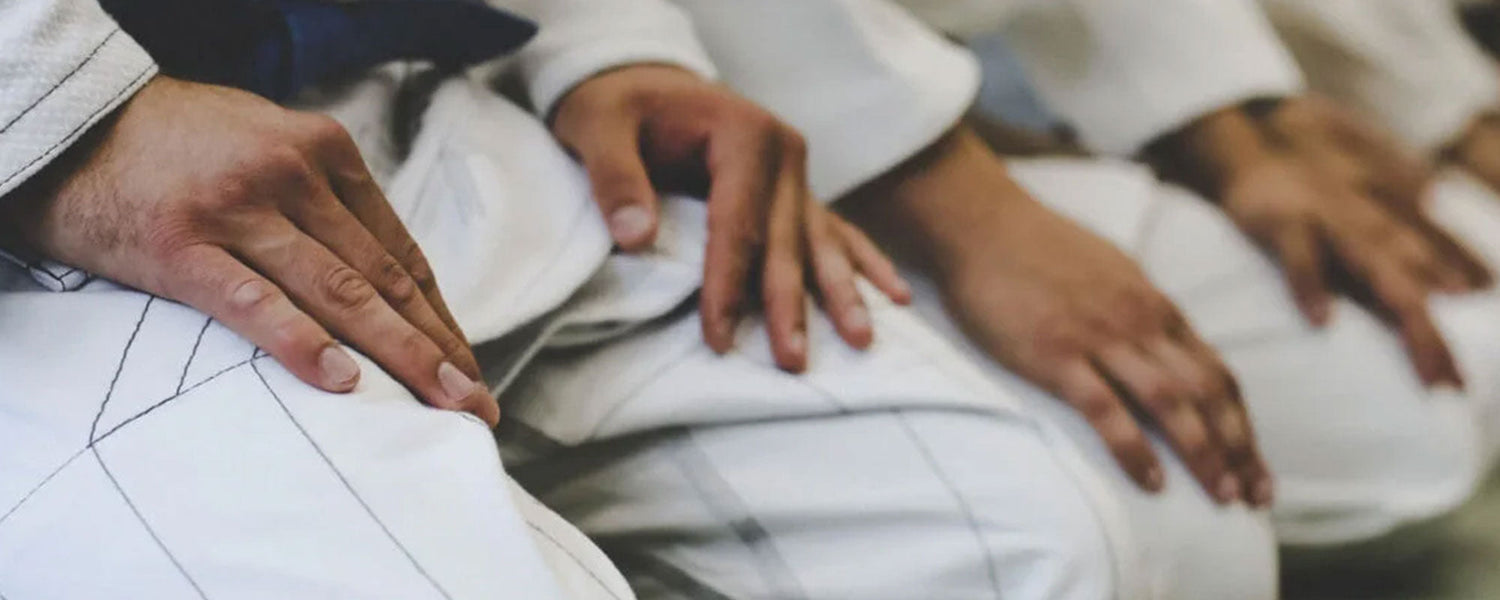Table of content
White belts are beginners in BJJ and the lowest in the BJJ belt ranking system. To progress up the belt system, white belts have to practice a lot of BJJ rolling. Rolling, also known as sparring, is a BJJ training session that trains white belts to practice different fighting techniques with a real opponent rather than dummies. But it is common for white belts to tire out if intense grappling exchanges happen, on the mat. Even if sparring white belts are equal in strength and skill, they may get exhausted from rolling. Why does this happen!
The reason BJJ white belts gas out is due to a lack of stamina and cardiovascular training. Fitness, balance, stamina, and muscle endurance are the key factors necessary for a BJJ white belt to sustain rolling on a mat. To support their endurance and stamina on the mat they have to work on some cardio stuff off the mat. Otherwise, they will huff and puff in the BJJ rolling.
1. Why Cardio for White Belts?
BJJ training is a strenuous activity that requires white belts to know how to manage their energy, breathing, and pacing. Tough training increases the heart and breathing rates. A sudden increase in heart and breathing rates can negatively affect the heart, lungs, and cardiovascular system of an untrained BJJ fighter.
As a white belt, if your body is not prepared to handle tough BJJ training then you will likely suffer more injuries from BJJ rolling. Cardio workouts improve the cardiovascular system of novice BJJ fighters to handle greater amounts of stress in intense grappling exchanges, as well as help with recovery.
Moreover, cardio workouts for beginners improve their stamina and help them become more fit. Furthermore, cardio exercises promote stability and coordination, a stronger immune system, weight loss, improved mental toughness, the release of anti-stress hormones (endorphins), and better muscle endurance in BJJ white belts. The metabolism of BJJ white belts also increases and helps them feel active on the mat. Increased aerobic strength due to cardio workouts enhances the speed and performance of white belt fighters.
2. Tips to Improve Cardio for White Belts
The following are some crucial tips to improve cardio in BJJ white belts:
2.1. Eat a balanced diet
If a BJJ white belt wants to improve cardio, then a fighter must focus on his/her diet as well. A healthy balanced BJJ diet helps to improve cardio fitness.
2.2. How much cardio intensity is required for BJJ white belts?
Because BJJ white belts are beginners low impact and simple cardio exercises are adequate training at first. A white belt should start cardio exercises at low intensity because they help strengthen back muscles and reduce back muscle injuries. BJJ white belts should avoid doing heavy cardio exercises because they may badly damage the joints. Once a BJJ white belt improves his/her stamina, then he/she can switch to moderate or HIIT cardio workouts.

2.3. Ideal Duration of a White Belt Cardio Workout
BJJ beginners don’t need to do a cardio workout for more than 30 minutes. A lot of people hurt themselves by doing intense workouts right at the start but overtraining can strain the muscles. Instead, start with 30 minutes of steady cardio at least three times a week. Once your body’s stamina and recovery improve, you can increase the intensity and pace of cardio exercises.

3. Cardio Exercises for BJJ White Belts
3.1. Mountain Climbers
Mountain climbing is a low-impact cardio activity. For this, you have to jog up a steep hill at a fast pace. When you reach the top of the hill, turn around and head down the hill at a fast pace.
Repetitions:
Repeat this workout several times for 30 minutes. Then continue to jog as you head back home. This will serve as a great cardio workout that will help you build up your stamina and endurance.
3.2. High Knees
High knees are cardio exercises that involve running in place while raising your knees to your chest. These exercises strengthen the leg muscles, as well as improve your momentum, coordination, flexibility, and heart rate.
Repetitions:
Repeat this exercise several times to improve cardio fitness.
3.3. Burpees
Burpees are one of the more exhausting exercises. It improves strength, agility, and endurance, serving as a great form of cardio.
For this exercise, the task is to squat down, extend your legs while keeping your arms straight, jump up, come back down to the ground, and do a push-up, before jumping back up again.
Repetitions:
The number of repetitions depends on the level of fitness you wish to attain.
3.4. Lunges
Lunges work out muscles in the legs and stretch the joints of the pelvic girdle. They involve turning the body, reverse, to the side, with a roll. Simple technically, they are effective when done correctly.
Repetitions:
Perform lunges slowly, letting the static load do the work.
3.5. Reverse and Side Lunges
Both the reverse and side lunges strengthen multiple muscle groups in the lower half, including the hamstring, glutes, calves, quads, abductors, and adductors. These exercises also activate your core, improving the balance and stability of your hip joints and legs.
Technique:
For reverse lunges stand straight, tight with your abs, roll your shoulders back and slightly forward lean then move your left leg back almost like a single leg squat, drop the knee down, and then press off that front foot.
For a side lunge, stand straight with feet hip-width apart and put your hands on the side of your hips. Then take a large step out to the right, put body weight on the right knee, slightly bend your knee at a 90-degree angle and keep stretching the left leg straight. Then step your right foot back to the middle. Switch the side and do the same exercise.
Repetitions:
Repeat the exercise several times for 2-3 sets with 10-15 repetitions for each set.
3.6. Jumping Jacks
Jumping jacks is an exercise that involves moving both your upper and lower body at the same time. It is considered a whole body workout. You don't need any equipment to do jumping jacks. This exercise can be used to warm up or as a form of interval training.
Starting Position:
Stand up with your arms by your side and legs together. Start by jumping and spreading your legs out to just a little wider than your shoulder width at the same time raise your arms above your head and return to the starting position.
Repetitions:
Try to repeat as many jumping jacks as you can in 45 seconds. Challenge yourself by repeating this with only a 15-second rest between sets.
3.7. Inchworms
As evident from the name, inchworms involve worm-like crawling movements. These are best for strengthening and stretching different muscle groups and improving blood circulation in the whole body. This is the best warm-up cardio activity before BJJ rolling that improves the cardiovascular system.
Starting position:
For practicing this, the fighter stands straight first and then lowers his arms towards the ground then starts a worm-like crawl movement with his hands away from his feet then waits and stretches for some time then again crawls back his hands to the feet and acquires the standing position again.
Repetitions:
Repeat this exercise several times to improve cardio fitness.
3.8. Cycling
Cycling is the best cardio workout for white belts as it is a full body workout. Regular cycling increases your overall cardiovascular fitness, body temperature, and breathing rate. Cycling is a low impact activity that will cause less strain and improve recovery. While cycling, the resistance from turning the pedals reduces pressure on your knees and hips and builds up muscular strength. Moreover, whether you are doing outdoor cycling or riding a stationary bike in a gym, your core, arm, and leg muscles will be strengthened. This will help improve your balance on the mat.
Repetitions:
Doing 30 minutes of cycling per day improves cardio fitness and muscular endurance.
3.9. Elliptical Running
Running on an elliptical machine is a low-impact cardio exercise. If you are injury-prone and have musculoskeletal problems, then this exercise is ideal for you. Usually, in BJJ sparring, BJJ white belts are more prone to injury. That is why elliptical running is effective because it is easy on the joints and helps to maintain fitness.
Starting position:
Stand straight, hold the handles by avoiding leaning on them, and set the incline and resistance. Move the pedals in a similar fashion to a natural movement of a run.
Repetitions:
As a beginner, a white belt should run on the elliptical machine for 20-60 minutes at least 3-5 times per week. The following chart is the standard 30-minute elliptical workout for BJJ beginners, showing the adjustments of incline and resistance.













Leave a comment
This site is protected by hCaptcha and the hCaptcha Privacy Policy and Terms of Service apply.